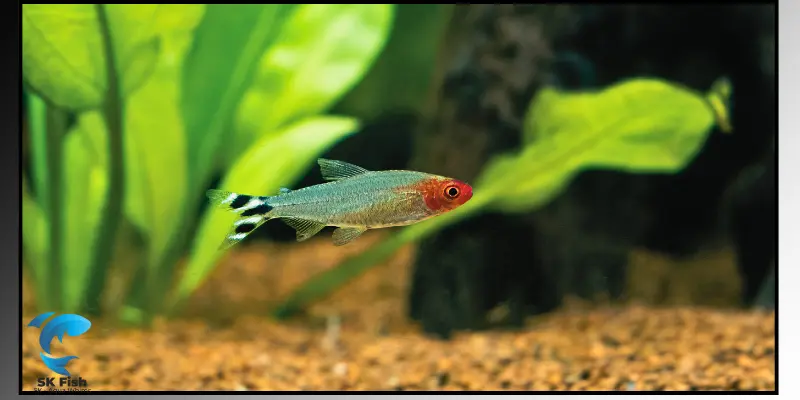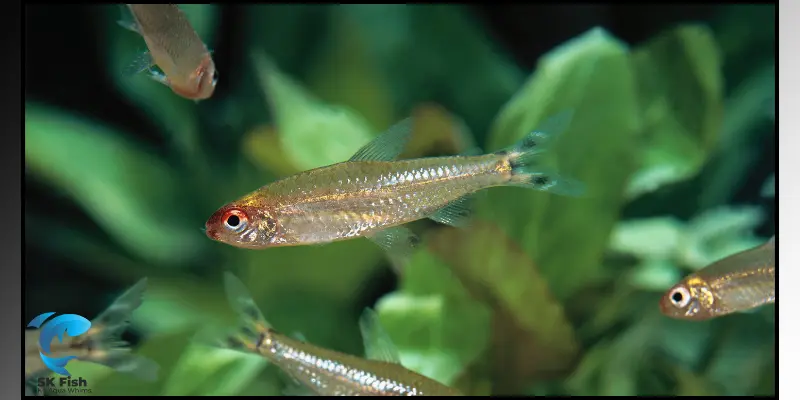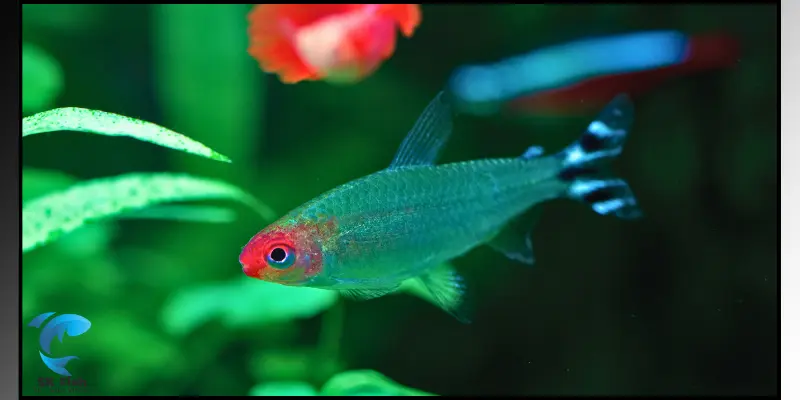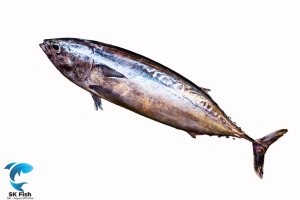Rummy Nose Tetra | Complete Aquarium Care Guide
Published: 17 Mar 2024
Welcome to the enchanting world of rummy nose tetra. These freshwater species are popular among fishkeepers worldwide, cherished for their vibrant colors, hues, and elegant movements.
Curious about how to care for rummy tetra in captivity? Look no further! Here, you’ll find a step-by-step guide to keeping these enchanting fish happy and healthy in your aquarium. Let’s dive in and explore their captivating life and unique aquarium care tips.
What is Rummy Nose Tetras?
Rummy nose tetras are small tropical freshwater species renowned for their torpedo-shaped profile. They are scientifically known as “Hemigrammus rhodostomus.” These peaceful creatures are in demand due to their schooling behavior and striking appearance.

Common Names
These amazing creatures have different names according to their body pattern and vibrant colors, such as:
- Red Nose Tetra
- Firehead Tetra
- Hemigrammus bleheri
- False Rummy Nose
Size and Weight
Rummy noses are small fishes, typically reaching an adult size of 0.5 to 1.5 inches. Due to their diminutive stature, these peaceful creatures are very lightweight, usually weighing only a few grams.
Lifespan and Reproduction
The lifespan of rummy nose tetras depends on various factors such as diet, environmental conditions, and overall care. On average, these vibrant fish can live for about 4 to 6 years when provided with proper care and a suitable environment.
As egg-laying species, rummy tetra reproduce by spawning in warmer areas of the tank, typically preferring to release their eggs on fine leaves or other surfaces. Providing ample vegetation and hiding spots in the aquarium is essential to mimic their natural habitat and encourage spawning behavior. During spawning, the female rummy nose tetra releases eggs, which are then fertilized by the male rummy nose tetra as he releases sperm. After approximately 2 to 3 days, the eggs hatch into larvae, beginning the fry’s development.
Aquarium Care Guide for Rummy Nose Tetra
The rummy nose fish require proper care because they are a sensitive species. Proper care increases the longevity of a rummy nose.

Tank Size
Due to their schooling behavior, a minimum tank size of 20 gallons is recommended for these stunning creatures. You can keep these fish with other small species like cichlids, corydoras catfish, and rasboras.
Tank Decor
Decorating your aquarium is essential for providing a stimulating and natural environment for your rummy nose tetras. Incorporating live plants, artificial plants, rocks, and plenty of hiding places creates a diverse and visually appealing habitat. Additionally, using a substrate that mimics their natural environment enhances the overall aesthetic and helps to replicate their wild surroundings.
Water Parameters
Maintaining appropriate water parameters is crucial for the well-being of your rummy nose fish. These fish thrive in slightly warmer water, ideally between 20 to 28 degrees Celsius. Additionally, ensure that the pH level of the waterfalls is within the range of 6 to 7, and keep a close eye on nitrate levels to ensure they remain at zero.
Regular Maintainance
Regular maintenance of your aquarium is essential to ensure the health and well-being of your tetras. Performing routine tasks such as regular water changes, cleaning the tank, and vacuuming the gravel helps to maintain a clean and healthy environment for your aquatic friends.
Diet for Rummy Nose Tetra
Rummy noses, being omnivores, thrive on a balanced and nutritious diet. These lively creatures exhibit active feeding behavior, exploring every nook of the tank for food. While they accept various types of food, here are some dietary options suitable for rummy nose tetras:
| Diet for Rummies |
|---|
|
How to Breed Rummy Nose Tetra?
Breeding rummy nose tetras can pose a challenge for fishkeepers, but there are steps to facilitate the process.

Selecting Breeding Pairs
It’s crucial to select healthy breeding pairs of rummies. Ideally, keep one male rummy nose tetra with two females to reduce stress and promote successful breeding. Before breeding, condition the adult fish by providing a varied diet of live foods.
Breeding Tank Setup
Create an optimal environment for breeding rummy nose tetras by setting up a tank with soft, slightly acidic water, aiming for a pH level below 6.5. Use a reliable heater to maintain a stable temperature conducive to breeding. Provide suitable spawning sites for the female rummy nose tetras, such as java moss or spawning mops, where they can deposit their eggs.
Egg Collection
After spawning, removing the adult rummies is crucial to prevent them from consuming the eggs. These fish are egg scatterers, releasing their eggs among plants and hiding places. Therefore, ensure that your breeding tank is well-equipped with ample plants and hiding spots.
Maturation
After hatching, rummy nose tetra eggs hatch into larvae, which initially sustain themselves by feeding on their yolk sacs. As they grow, they transition to consuming tiny live foods. These stunning creatures experience rapid growth, reaching sexual maturity in just a few months.
Conclusion
In conclusion, our journey through the world of rummy nose tetras has unveiled their stunning beauty and unique care requirements. From learning their common names to understanding their size, weight, and breeding habits, we’ve gained valuable insights into providing the best care for these captivating fish. We hope this guide empowers you to create a thriving environment for your rummy nose tetras in your aquarium. Don’t hesitate to share your thoughts and experiences in the comment section below. Happy fishkeeping!
FAQs
How many rummy nose tetras should be kept together?
Rummy nose tetras are schooling fish and should ideally be kept in groups of at least six individuals. However, for optimal observation of their natural swimming behavior, a group of 10 to 12 individuals is recommended.
Can angelfish live with rummy nose tetras?
Typically, it’s not recommended to house rummy nose tetras with angelfish, as the larger angelfish may prey on the smaller tetras. However, if you still wish to keep them together, it’s essential to ensure that the angelfish are smaller in size compared to the tetras.
Are rummy nose tetras hard to keep?
Rummy nose tetras are generally easy to care for, but some fishkeepers caution beginners against keeping these small fish. However, with proper research and understanding of their needs, even novice aquarists can successfully care for these stunning fish.
Are rummy nose tetras rare?
No, rummy nose tetras are not considered rare; they are widely available in pet stores and online retailers. They boast vibrant coloration and unique patterns.

SK Fish is your trusted source for practical fish care tips and delicious seafood recipes. Our team is dedicated to providing reliable, well-researched content for fishing enthusiasts and home cooks alike.

- Be Respectful
- Stay Relevant
- Stay Positive
- True Feedback
- Encourage Discussion
- Avoid Spamming
- No Fake News
- Don't Copy-Paste
- No Personal Attacks



- Be Respectful
- Stay Relevant
- Stay Positive
- True Feedback
- Encourage Discussion
- Avoid Spamming
- No Fake News
- Don't Copy-Paste
- No Personal Attacks





